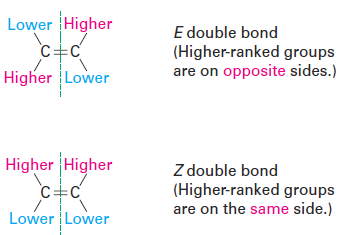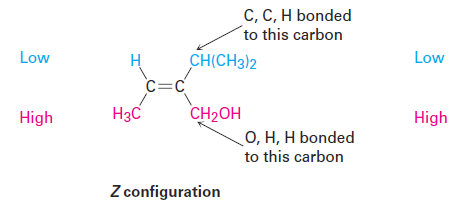

علم الكيمياء

تاريخ الكيمياء والعلماء المشاهير

التحاضير والتجارب الكيميائية

المخاطر والوقاية في الكيمياء

اخرى

مقالات متنوعة في علم الكيمياء

كيمياء عامة


الكيمياء التحليلية

مواضيع عامة في الكيمياء التحليلية

التحليل النوعي والكمي

التحليل الآلي (الطيفي)

طرق الفصل والتنقية


الكيمياء الحياتية

مواضيع عامة في الكيمياء الحياتية

الكاربوهيدرات

الاحماض الامينية والبروتينات

الانزيمات

الدهون

الاحماض النووية

الفيتامينات والمرافقات الانزيمية

الهرمونات


الكيمياء العضوية

مواضيع عامة في الكيمياء العضوية

الهايدروكاربونات

المركبات الوسطية وميكانيكيات التفاعلات العضوية

التشخيص العضوي

تجارب وتفاعلات في الكيمياء العضوية


الكيمياء الفيزيائية

مواضيع عامة في الكيمياء الفيزيائية

الكيمياء الحرارية

حركية التفاعلات الكيميائية

الكيمياء الكهربائية


الكيمياء اللاعضوية

مواضيع عامة في الكيمياء اللاعضوية

الجدول الدوري وخواص العناصر

نظريات التآصر الكيميائي

كيمياء العناصر الانتقالية ومركباتها المعقدة


مواضيع اخرى في الكيمياء

كيمياء النانو

الكيمياء السريرية

الكيمياء الطبية والدوائية

كيمياء الاغذية والنواتج الطبيعية

الكيمياء الجنائية


الكيمياء الصناعية

البترو كيمياويات

الكيمياء الخضراء

كيمياء البيئة

كيمياء البوليمرات

مواضيع عامة في الكيمياء الصناعية

الكيمياء الاشعاعية والنووية
Alkene Stereochemistry and the E,Z Designation
المؤلف:
John McMurry
المصدر:
Organic Chemistry
الجزء والصفحة:
9th. p 194
17-5-2017
3777
Alkene Stereochemistry and the E,Z Designation
The cis–trans naming system used in the previous section works only with disubstituted alkenes—compounds that have two substituents other than hydrogen on the double bond. With trisubstituted and tetrasubstituted double bonds, a more general method is needed for describing double-bond geometry. (Trisubstituted means three substituents other than hydrogen on the double bond; tetrasubstituted means four substituents other than hydrogen.)
The method used for describing alkene stereochemistry is called the E,Z system and employs the same Cahn–Ingold–Prelog sequence rules given in for specifying the configuration of a chirality center. Let’s briefly review the sequence rules and then see how they’re used to specify doublebond geometry.
Rule 1
Considering each of the double-bond carbons separately, look at the two substituents attached and rank them according to the atomic number of the first atom in each. An atom with higher atomic number ranks higher than an atom with lower atomic number.
Rule 2
If a decision can’t be reached by ranking the first atoms in the two substituents, look at the second, third, or fourth atoms away from the double-bond until the first difference is found.
Rule 3
Multiple-bonded atoms are equivalent to the same number of singlebonded atoms. Once the two groups attached to each double-bonded carbon have been ranked as either higher or lower, look at the entire molecule. If the higherranked groups on each carbon are on the same side of the double bond, the alkene is said to have Z geometry, for the German zusammen, meaning “together.” If the higher-ranked groups are on opposite sides, the alkene has E geometry, for the German entgegen, meaning “opposite.” (For a simple way to remember which is which, note that the groups are on “ze zame zide” in the Z isomer.)

As an example, look at the following two isomers of 2-chloro-2-butene. Because chlorine has a higher atomic number than carbon, a -Cl substituent is ranked higher than a -CH3 group. Methyl is ranked higher than hydrogen, however, so isomer (a) is designated E because the higher-ranked groups are on opposite sides of the double bond. Isomer (b) has Z geometry because its higher-ranked groups are on ze zame zide of the double bond.
For further practice, work through each of the following examples to convince yourself that the assignments are correct:

Assigning E and Z Configurations to Substituted Alkenes Assign E or Z configuration to the double bond in the following compound:

S t r a t e g y
Look at the two substituents connected to each double-bonded carbon, and determine their ranking using the Cahn–Ingold–Prelog rules. Then, check whether the two higher-ranked groups are on the same or opposite sides of the double bond.
S o l u t i o n
The left-hand carbon has -H and -CH3 substituents, of which -CH3 ranks higher by sequence rule 1. The right-hand carbon has -CH(CH3)2 and -CH2OH substituents, which are equivalent by rule 1. By rule 2, however, -CH2OH ranks higher than -CH(CH3)2 because the substituent -CH2OH has an oxygen as its highest second atom, but -CH(CH3)2 has a carbon as its highest second atom. The two higher-ranked groups are on the same side of the double bond, so we assign a Z configuration.

 الاكثر قراءة في الهايدروكاربونات
الاكثر قراءة في الهايدروكاربونات
 اخر الاخبار
اخر الاخبار
اخبار العتبة العباسية المقدسة

الآخبار الصحية















 قسم الشؤون الفكرية يصدر كتاباً يوثق تاريخ السدانة في العتبة العباسية المقدسة
قسم الشؤون الفكرية يصدر كتاباً يوثق تاريخ السدانة في العتبة العباسية المقدسة "المهمة".. إصدار قصصي يوثّق القصص الفائزة في مسابقة فتوى الدفاع المقدسة للقصة القصيرة
"المهمة".. إصدار قصصي يوثّق القصص الفائزة في مسابقة فتوى الدفاع المقدسة للقصة القصيرة (نوافذ).. إصدار أدبي يوثق القصص الفائزة في مسابقة الإمام العسكري (عليه السلام)
(نوافذ).. إصدار أدبي يوثق القصص الفائزة في مسابقة الإمام العسكري (عليه السلام)


















